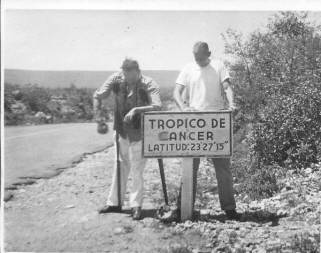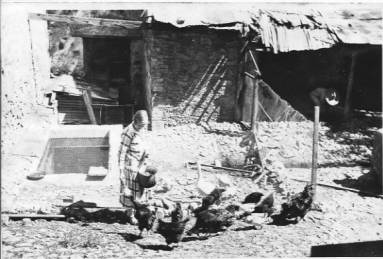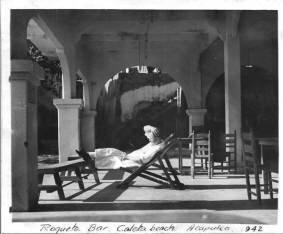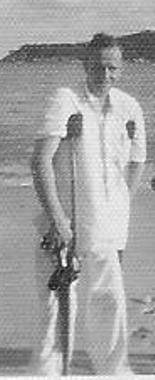

My father Walter Glanville Ough was the youngest son. The eldest was his brother Sydney Henry Ough who was four years older. The third member of the trio was my Aunt Amy born half way between the brothers in 1907. Unlike them she was born in England. Syd and Walter were born in Mexico.
The following are Dad’s memories about his much revered brother. They are the best introduction to this wonderful uncle.
“My memory is clear in helping my brother Syd manufacture gun powder which we used in a contraption called a key and nail gun, to deface stonework with a horrible yellow stain.
The Buckinghamshire village that was our home during the first war had no electricity, gas or piped water, so one used paraffin lamps for illumination, anthracite coal for cooking and heating, and water had to be hand pumped from a well in the garden. The loo was an outhouse and bloody cold in winter when snow could be five feet deep.
School for my sister and me was over three miles away at Ellesborough at the foot of Coombe Hill, the highest summit of the Chilterns, which was crowned by a huge monument to the dead of the South African War, and whose apex was a stone flame visible in seven counties. It was here that a bonfire was lit on Armistice Night to celebrate the end of World War 1.
By far the most influential man in my youth was my elder brother Syd. Henry Sydney Ough, four years older than myself, born in San Luiz de la Paz, Mexico in 1905 and stricken with polio in 1909, the year I was born. ‘Polio’ or Infantile paralysis as it was known in those days was accompanied in his case by Spinal Meningitis and the combination was tragic.
Syd was paralysed from the hips down and was never able to walk again. With the aid of crutches, he could swing along slowly and even climb steps if there was a handrail to steady him. Our mother who had been a professional nurse in London before her marriage, took us to England in 1910 and had Syd examined by several specialists and given treatment to improve his gait, but sadly there was nothing that could be done for him. The Salk Anti-Polio vaccine was not yet in existence.
Syd was the most patient, kindly and uncomplaining person I have ever known. He was never able to participate in sports or adventurous activities, so was denied the excitement and thrills that Amy and I enjoyed. As I grew older, I could occasionally discern a wistful look in his eyes, but he never referred to his disability with self pity or rebellion.
He had a first class brain and developed a profound knowledge of electric and electronic phenomena, especially radio and television. He was a keen photographer and home movie expert, doing his own developing and printing.
Finding it difficult to move around to reach things or to travel on foot, he relied on me to act as leg man, also to push his wheelchair up hills when he went out. Associating with him, I was encouraged to read boys adventure books that he had enjoyed, and profit by his descriptions and explanations of various phenomena in all branches of learning. After our father died in 1934, Syd took over his job as manager of the Maravillas Company until its demise in 1937. He later accepted work in the Loreto Mill office under Alan Probert and was assigned a dwelling house close by which was most convenient. He remained there until his health began to fail and he died shortly after being transferred to the Cowdray Hospital in 1955, aged only fifty. He was buried in the British Cemetery in Mexico City.”

My own memories of Uncle Syd are based on a much shorter time span of just 8 years. I acquired them in the years between 1938 when I was old enough to form any kind of a lasting memory and 1946 when I was sent to boarding school in Jamaica. I saw Uncle Syd just once more and that was very briefly in 1949 during my only precious holiday back in Mexico from school. I never saw him again after that, much to my lasting regret.
My memories are kaleidoscopic. But there was the overriding impression of a patient avuncular, good humoured, highly intelligent man who overcame his grave disabilities to become expert in several areas. These all had the common requirement for an intelligent, enquiring mind and the application of a good knowledge of the sciences. For a start he was an expert in photography, being one of the first in the field of moving pictures and colour. Not only did he take his own pictures, he also developed them. Most of the 8mm films now in my possession were made by Uncle Syd. They provide a wonderful, if very dated window of past family history. They include some of the earliest films of Mickey Mouse and Donald Duck.
He also was highly knowledgeable and proficient in the then new applications of radio and the recording/reproduction of sound. He was one of the first to make a working wire recorder... a machine that was developed before the better known tape recorder of more modern times.
Uncle Syd spent hours in his workshop....it was a small room where everything he needed was at hand. The long work bench was backed by racks of small drawers filled with every piece of hard ware imaginable. It was rather like an old fashioned apothecary’s shop that housed engineering bits and pieces rather than medicines and potions.
The top of his work bench always had at least one, more often two or three current projects. One he kept on the bench for a long time fascinated my small boy’s imagination. It consisted of an ordinary incandescent light bulb to which were attached several pieces of tin foils and wires. When it was switched on it produced miniature strokes of lightening between the tinfoil on the glass and the tungsten filament on the inside. This was doubling fascinating for me because I linked that with the frequent thunder storms that were common in the rainy season. The tiny lightening strokes in the bulb were a model of the massive strokes of lightening we sometimes experienced.
He could turn his hand to anything that involved electricity. Even to the electric train I was given for Christmas in the early ‘40s. This was an American set which sported an engine, several carriages and a circular railway track. With its transformer connected to provide power I could make this train go round the track faster and faster until it derailed itself. It paralleled an exactly similar set given that year to my cousin. He too discovered how to derail his train and that kept us occupied for a while. But we soon tired of that and both sets lost their popularity. Then they disappeared, not that either Noel or I really noticed.
About two months later on one of the family weekend gatherings at my grandmothers place in the old Progresso Hacienda in Pachuca ( part of the Maravillas mine company staff housing) Noel and I were told to open the door of a room that had been rarely used. This revealed an Aladdin’s cave of railway marvels. My father, Uncle Cecil ( Noel’s Dad) and Uncle Syd had conspired together to set up both our train sets in this room. But the whole set up was something else and could only have been the work of one man...Uncle Syd. Dad and Uncle Cecil had provided the muscle and no doubt the train sets. Uncle Syd had done the rest.


There was a very large table in the middle of the room with a large hole in the middle and an access way to get to it. The surface was covered in an array of railway tracks, switch yards, stations and long haulage lines in between They had contrived to include a miniature mountain range with tunnels and bridges. The piece de resistance was the control box which was built to resemble an old fashioned signal box full of transformers, switches and levers. Everything, including the two engines could be controlled from this one place. The next most remarkable feature was a draw bridge that bridged the gap in the table giving access to the area in the centre of the table. This provided support for two railway lines and could be raised and lowered in the most realistic way, controlled of course from the control centre. It had an old sardine tin filled with lead as a counter weight an example of Uncle Syd’s ingenuity and ability to make do.
Both Noel and I were of course absolutely fascinated by all this and immediately wanted to get involved again with our now much more interesting trains. But we reckoned without the new rules imposed by our adult benefactors. First we had to learn to understand how everything worked and was controlled. Second we could only, at least at the beginning, use the new play thing under adult supervision and train wrecks were definitely off the menu. Thirdly as the installation was now a permanent one we could only use it when the family gathered at Gran’s at weekends. Noel soon dropped out as his interests lay elsewhere. I persevered for a while longer and learnt a lot from Uncle Syd, especially in how things worked and why. But sadly I too found other more easily accessible occupations and gradually lost interest, much to my later regret.
Some years later Uncle Syd and Gran had to move from Hacienda Progreso. Sadly the Aladdin’s cave was dismantled as was Syd’s workshop. I cannot remember seeing anything of the trains after that, I suppose they were sold off along with the rest of the paraphernalia. Sad for me and Noel, but even more so for Uncle Syd as it was he who had been mainly responsible for creating and building so many of the home made marvels in that model train room.
But my fondest memory of Uncle Syd involved chickens. Whilst he and Gran lived at Progresso, Gran had taken to keeping a small flock of chickens and the occasional turkey in one of the backyards of the compound at the back of her house. These were a source of eggs meat and feathers. I have memories of a dead chicken or two being plucked with its entrails removed in preparation for the pot.
The hacienda, built in the traditional fashion of those days was surrounded by high, very thick stone walls. Access to the compound inside was through large high gates built of solid wood. These could be swung open on massive hinges to allow cars in. One half of the gate was pierced by a small door giving access for pedestrians. A "Portero" was employed with sole responsibility to control access to the hacienda and he kept visual check on the inside from a small stone walled, circular tower like structure with semi conical roof. He could just see what was going on outside through small slits in the stone work.
The stone wall and the Portero were provided for the security of company staff living in the houses within the compound. This security was enhanced by the topping of the stone wall by broken glass cemented into the top as a sort of capping....an early precursor of the razor edge wire of our more modern times. Theft, burglary and worse were unfortunately a constant threat in those days.
Anyhow, their relatively tranquil life was upset when in the middle of the night an awful racket erupted in the chicken run. Something had frightened the birds and the caterwauling and scrambling made enough noise to wake both Uncle Syd and Gran. Neither being able to investigate they left things to die down and waited until the morning to discover the cause.
The morning revealed some damage to the chicken run and the loss of several chickens.
A few nights later the same thing happened with a similar result. Uncle Syd complained to the local police, but being well experienced of life in Mexico, he knew he’d have to rely on his own resources to solve the problem. "La Policia" were a most unreliable resource.
So he set up a series of trip wires connected to old fashioned photographic flash bulbs and magnesium flares. He also set up a camera strategically placed to survey the chicken run.
He then waited. It was not long before his patience was rewarded. Again in the middle of the night all hell broke loose .There was the hubbub of scared chickens this time punctuated by flashes of light as the flares and bulbs went off. Again he waited until the morning to discover what had happened. But this time he had a record. He removed the film from the camera and developed it in his workshop. The result was several pictures of the coop with the high stone wall in the background. Most showed nothing of value, but one was gold dust!
This showed the back wall with several hessian sacks thrown over the brocken shards of glass. Sitting astride the wall were three local men. Two wore the traditional farmers costume of rather grubby white trousers and a smock, with feet protected by the traditional huarache.. the local leather sandal. The third man in the middle however, was still in his policeman’s uniform......and all three had several chickens in their grip.
This was irrefutable evidence and gave Uncle Syd the chance he needed to exact some sort of retribution and justice.
So he got a lift and went off next day to the local police station, armed with the damaging evidence. Now Mexican police stations in those days were not the most salubrious of places. The force was very poorly paid and the facilities reflected the lack of money. Dingy, dirty and down at heel was the general impression. The entrance was guarded by a couple of police and gave way to a dark somewhat small waiting room populated by several lounging men of distinctly unattractive appearance plus some poor women hoping to have their cases attended to. The atmosphere was distinctly one of "abandon hope all ye that enter here"!
Undismayed Uncle Syd demanded to see "El Jefe" the Chief himself. After the usual interminable wait Uncle Syd was told to go to the great man’s office at the end of a long corridor. So, still on his crutches and with no offers of help, he found his way into the office. This was a somewhat grander affair in that there was an open window which lightened the place and revealed a large desk behind which lounged the Chief himself smoking the inevitable cigarette. He was a man of average height with a large belly, yet reasonably smartly uniformed. A gun belt and revolver, badges of his office , no doubt, hung on a hook behind him. His sharp swarthy features were enhanced by the traditional pencil thin moustache and piercing hard black eyes.
The Police Chief lost no time. Without offering Uncle Syd a seat and remaining seated himself he asked him "Que es la problema senor"?
Uncle Syd responded simply by placing the damming photographic evidence on the man’s desk and pointed to it. The Chief looked at the photo and gave it some thought as he concentrated on the face of the man in the middle. Then he yelled out in stentorian tones "JORGE"! and waited.
Shortly there was a knock on the door and a rather chastened, scruffy member of the local constabulary appeared. " Si Jefe?" he asked , trying to look nonchalant, attentive, intelligent and innocent all at the same time. But there was absolutely no doubt about the exact resemblance between this man and the policeman in the photo.
Without wasting a moment the Chief suddenly got out of his chair, marched sharply around to his subordinate, showed him the photo, promptly and cruelly slapped him hard in the face and then turned to my uncle.
"OK Senor? Todo es arreglado y en orden ahora? OK Now?" and showed him to the door.


There was no other noteworthy sequel to this example of Mexican rough justice except that the raids on Gran’s chickens were never repeated and life returned to the somnolence of the habitual Mexican way of those days and the regular siesta.
I still have a couple of things in my own workshop to remind me of Uncle Syd. One is a set of carving chisels and associated paraphernalia that is in a box which must be over a century old. The other is a gold watch that dates back to 1825.
I was lucky to have known Uncle Syd and to have been so beneficially influenced by a man who rose above the vicissitudes of a harsh life to retain a sense of humour, intellectual adventure yet who found the time to encourage a small boy to explore things for himself.
Copyright of all parts of site is owned by M.& M.M. Ough Dealy
This page last modified on Wednesday, 3 August, 2021